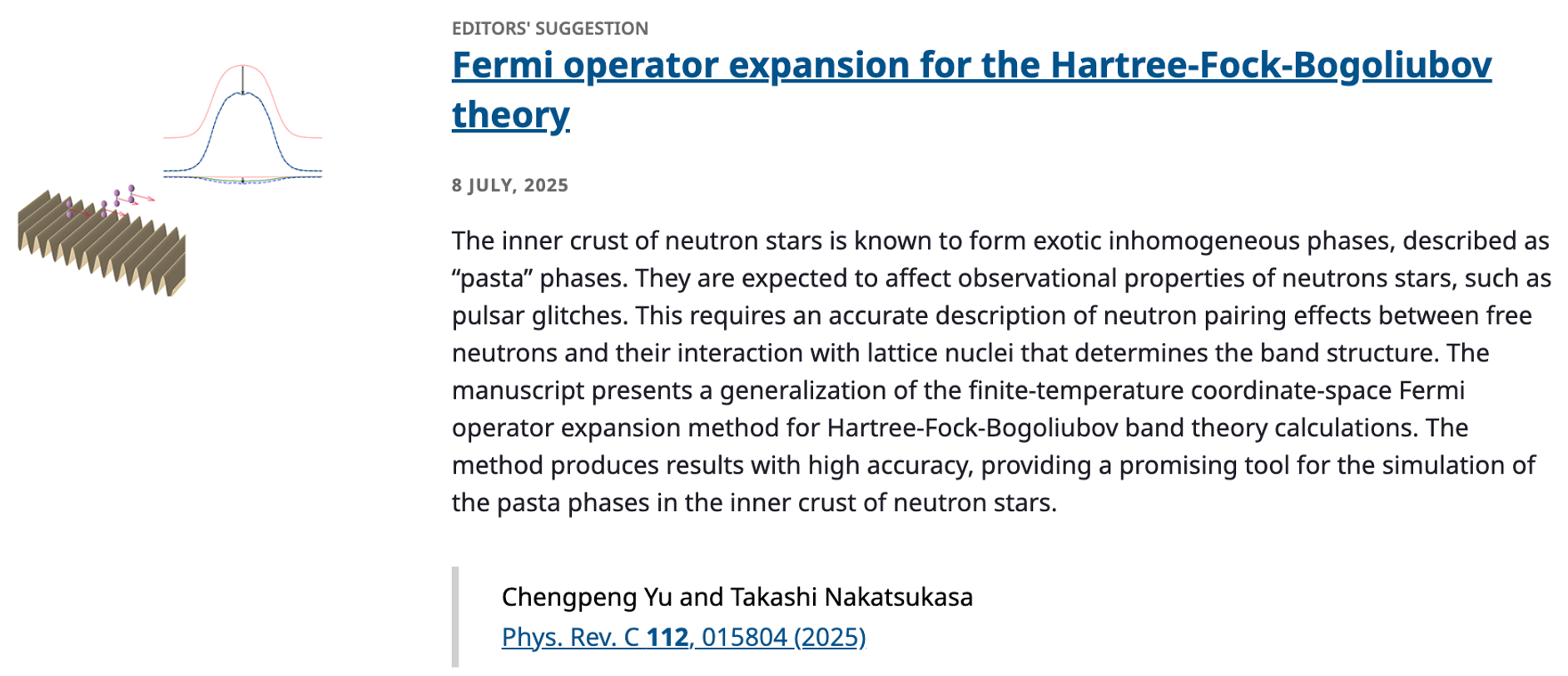新メンバー:Liさん New member: Li
2025年12月8日 | 新着情報
Dr. Gubler (Peking University) has joined our group as a new foreign research fellow.
外国人受託研究員として北京大学のLiさんが研究室のメンバーに加わりました。
2025年12月8日 | 新着情報
Dr. Gubler (Peking University) has joined our group as a new foreign research fellow.
外国人受託研究員として北京大学のLiさんが研究室のメンバーに加わりました。
2025年11月4日 | 新着情報
The following seminar will be held on November 7th, 2025, in Meeting Room A, CCS, University of Tsukuba.
Lecturer: Philipp Gubler (JAEA)
Place: Meeting Room A (1F), Center for Computational Sciences, University of Tsukuba
Date/Time: November 7th, 2025, 13:45-
Title: Understanding the generation of hadron masses from QCD and experimental data
Abstract: It has long been assumed that a large part of the mass of hadrons is generated by the spontaneous breaking of chiral symmetry of the strong interaction, which is successfully described by Quantum Chromodynamics (QCD). A clear confirmation of this mechanism from experimental measurements has, however, been elusive, in part due to the difficulty in measuring the order parameter of chiral symmetry, e.g. the chiral condensate. One method for potentially clarifying the relation between chiral symmetry and the hadron masses, is to probe the behavior of hadrons in nuclear matter, where chiral symmetry is believed to be partially restored. For this to work, one needs both a good theoretical understanding of the behavior of hadrons in matter and, equally important, how such a behavior will be reflected in experimental observables. In this seminar, I will first review the basic concepts needed to understand the relation between hadron masses and chiral symmetry of the strong interaction. I will then give an elementary introduction to the method of QCD sum rules, which has been an important theoretical tool in this field and will provide an overview of its use in current research. Next, I will review selected past and current experiments that have tried to study hadrons in dense matter and introduce methods on how the corresponding experimental data are analyzed, focusing particularly on the use of numerical transport simulations.
2025年11月1日 | 新着情報
Prof Gubler (Japan Atomic Energy Agency) has joined our group as a new associate professor (Cooperative Graduate School).
連携大学院准教授として日本原子力研究開発機構のGublerさんが研究室のメンバーに加わりました。
2025年9月8日 | 新着情報
Mr Ishikuro, a student in the Master’s course, has received TIA NanoGreen Summer School Encouragement Award. The school was held at University of Tsukuba in September 10-12, 2025. Congratulations!
2025年9月10ー12日に筑波大学で開催されたTIAナノグリーン・サマースクールにおいて、石黒さん(M1)が奨励賞を受賞しました。おめでとうございます!
2025年8月1日 | 新着情報
Mr. Shoji received the Presentation Award at the Particle Physics Computing Consortium Summer School (PPCC-SS-2025).
庄司拓未さん(物理学学位プログラムM2)が第8回粒子物理コンピューティングサマースクール(PPCC-SS-2025)にて優秀発表賞を受賞しました。
2025年7月8日 | 新着情報
Yuさんと中務さんの論文が、ジャーナルPhysical Review CにおいてEditors’ suggestion に選定されました。フェルミ演算子法のHartree-Fock-Bogoliubov理論への応用が可能であることを示した成果です。
A paper by Drs Yu and Nakatsukasa have been selected as “Editors’ suggestion” in Physical Review C. The paper reports the applicability of Fermi Operator Expansion Method to the Hartree-Fock-Bogoliubov theory.

2025年5月1日 | 新着情報
A new postdoc researcher, Dr. Tsunoda has joined our group.
ポスドク研究員の角田さんが研究室のメンバーに加わりました。
2025年4月5日 | 新着情報
Three new graduate students in the Master course, Akai, Ishikuro, and Chiba, have joined our group. In addition, three undergraduate fourth-year students, Ishii, Uchino, and Tokinaga, will perform the graduation research in our group.
大学院生(M1)の赤井さん、石黒さん、千葉さん、4年生・卒研生の石井さん、内野さん、時長さんが研究室のメンバーに加わりました。
2025年3月25日 | 新着情報
Ms. Ruike has received the Dear Award of Degree Programs in Pure and Applied Sciences.
類家千怜さん(物理学学位プログラム M2)が数理物質科学研究群長賞を受賞しました。
| 新着情報
Mr. Ochi, Mr. Kanai, Ms. Ruike have been awarded the Master degree of Science on March 25th, 2025. Mr. Akai and Mr. Chiba have been awarded the Bachelor degree of Science on March 25th, 2025.
越智さん、金井さん、類家さんが修士(理学)を取得しました。また、赤井さん、千葉さんが学士(理学)を取得しました。